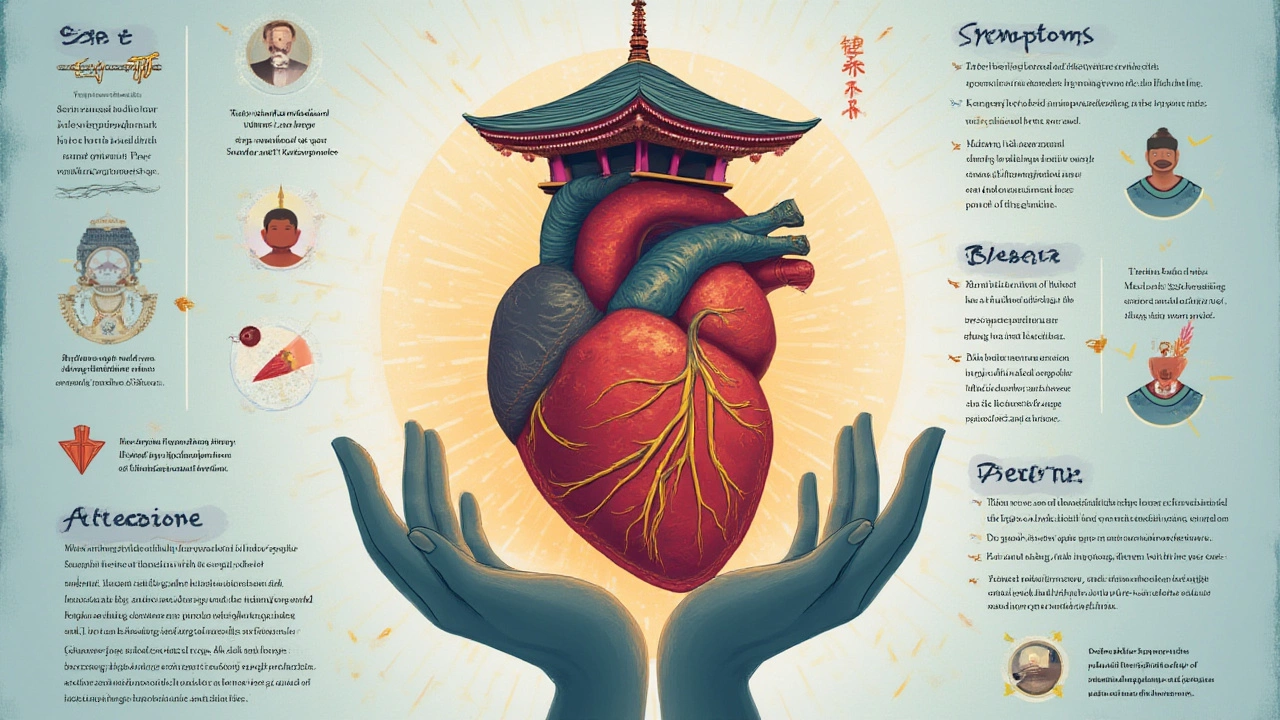
Hear the phrase “broken heart,” and you might think of lost love or sad goodbyes. But in Japan, a broken heart is more than a feeling—it’s a real medical condition with a uniquely poetic name: Takotsubo cardiomyopathy. This heart disease shows up out of nowhere, hitting mostly women, often after a shocking stressor or a dramatic emotional event. What’s wild is that it mimics a heart attack, even sending people to the ER, but when doctors check, coronary arteries look pretty clear. So, what’s going on inside the heart, and why did this disease earn such a distinct Japanese label? Let’s pull back the curtain.
Origins and Meaning: What is Takotsubo Cardiomyopathy?
Takotsubo cardiomyopathy, often called “broken heart syndrome,” was first identified in Japan in 1990 by Dr. Hikaru Sato. The name “Takotsubo” refers to a traditional Japanese octopus trap, which has a bulbous, pot-like shape. That’s because, on imaging, a stressed heart with this syndrome balloons out at the bottom, resembling those octopus pots. Pretty vivid visual, right? In Japan, and gradually around the world, cardiologists realized this isn't a rare condition after all. It just went unseen for years since its symptoms look so much like a classic heart attack.
Takotsubo cardiomyopathy appears suddenly, usually following an intense physical or emotional event—things like the unexpected death of a loved one, a break-up, domestic stress, or even extremely happy surprises. Compared to typical heart attacks, which mostly affect older men, Takotsubo strikes mainly post-menopausal women. The ratio? Roughly 9 out of 10 patients are female, and the average age is around 60 to 75. There’s a real mind-body link at play, and social scientists have noticed cultural aspects in how the disease is discussed and diagnosed in Japan.
What’s really going on in those first scary hours? Takotsubo causes parts of the heart muscle—usually the left ventricle—to suddenly weaken. The rest of the heart keeps pumping, but that ballooning section doesn’t contract properly. This causes chest pain, shortness of breath, a racing pulse, and even fainting—basically all the classic heart attack symptoms. Trouble is, blood tests and EKGs raise red flags, but angiograms come back without blocked arteries. That’s what tips off Japanese doctors, and now doctors worldwide, to this unique diagnosis.
Fascinating Facts and Myths Around Takotsubo Disease
This disease is packed with surprising details. Some think it’s rare, but recent studies show about 2% of all patients (and up to 7% of women) who show up with suspected heart attacks actually have Takotsubo. In Japan, one of the world’s healthiest nations for the heart, people are still vulnerable—emphasizing how crucial mental health and community stability are to physical health. You might even remember stories that made headlines: after big earthquakes, public tragedies, or even when a favorite sports team suffered a crushing defeat, Japanese hospitals reported a spike in Takotsubo cases. Stress isn’t just “all in your head” after all!
Another myth: Takotsubo is just a harmless scare. While many recover fully within weeks, it’s far from a harmless fluke. Up to 10% develop serious heart failure or other complications, and there’s a risk of relapse. Strikingly, Takotsubo has its own international registries now, so we are learning more every year. The disease has even been reported after extreme happiness (“happy heart syndrome”), like winning the lottery or a surprise birthday party. Think your body doesn’t care about feelings? The heart very much disagrees.
Here’s an interesting stat: according to a 2023 review in the European Heart Journal, about 20-30 per 100,000 people in Japan may experience Takotsubo cardiomyopathy each year. In-hospital mortality ranges from 1% to 5%, which is lower than traditional heart attacks, but not negligible. Plus, the psychological toll shouldn’t be downplayed—many patients report weeks or months of lingering anxiety or fatigue after “the big event.”

Symptoms, Diagnosis, and What Sets Takotsubo Apart
So how can you tell if it’s a Takotsubo event or a regular heart attack? Honestly, you can’t without medical help. The overlap is huge: sudden chest pain, crushing fatigue, sweating, shivering, irregular heartbeat, and sometimes fainting. The difference comes down to what doctors see on tests. Standard heart attacks show blockages—blood clots or plaques clogging the arteries. Takotsubo hearts, in contrast, show a ballooning ventricle on ultrasound or MRI but clear arteries during angiogram.
Doctors in Japan have gotten really good at spotting the signs. The diagnosis usually follows criteria developed in the late 1990s, including (1) sudden, temporary weakening of the left ventricle, (2) chest pain or shortness of breath after a stressful event, (3) no major coronary blockages, and (4) new changes on EKG. Blood tests may show mild heart damage markers, but typically less than a classic heart attack. In fact, autopsy registries in Japan have helped fine-tune the criteria.
Here’s a quick breakdown of common triggers, based on a 2022 observational study from Kyoto University:
| Trigger/Event | Percentage of Patients |
|---|---|
| Emotional stress (grief, shock) | 36% |
| Physical illness (infection, surgery) | 30% |
| Unknown/No apparent trigger | 34% |
Because the disease doesn’t discriminate between negative and positive stress, both “good” and “bad” shocks can trigger it. The window for symptoms can be as short as hours and as long as several days after the stressor.
Japanese Heart Culture: Why Does Takotsubo Occur?
So, why does Takotsubo seem to pop up so often in Japan? Partly, it’s because Japanese doctors were the first to recognize and research it, but there’s a bigger cultural story. Japanese language and culture pay close attention to heart-health connections—for example, the character “kokoro” (心) means both “heart” and “mind.” There’s frequent talk about gaman (enduring hardship) and the idea of bottling up emotion for social harmony. In some ways, these habits might make people more prone to a system-overload reaction—one big emotional hit after long periods of quiet stress.
“Takotsubo syndrome is a classic example of the heart and mind being inseparable. In Japan, emotional restraint can set the stage for sudden cardiac stress,”says Dr. Kenji Yamada, a cardiologist at Osaka University Hospital, quoted in a 2024 health feature in The Japan Times.
Modern stressors like natural disasters (think earthquakes and tsunamis), work-related burnout, and even communal celebrations all play a role. Japanese researchers are exploring genetic and hormonal links—early studies suggest certain gene types and low estrogen levels might make post-menopausal women more susceptible. But the big story is how daily lived experience, culture, and sensitive hearts intersect.
Japan isn’t alone, though. Global awareness is rising. The same syndrome is now documented in North America, Europe, and everywhere with high-stress, close-knit communities. Still, the name Takotsubo cardiomyopathy remains uniquely Japanese, a little stamp of cultural history left on a global medical mystery.

Managing and Preventing Takotsubo: Tips and Insights
There is no magic pill to wipe out Takotsubo for good. Since the main cause seems to be a surge of adrenaline or similar “stress” hormones, most treatments are focused on supporting the heart while it recovers. Hospital stays last anywhere from a few days to a week, usually with careful monitoring, heart meds to ease the workload, and sometimes therapy to help process the triggering event.
If there’s a silver lining, it’s that the vast majority recover fully, with the heart snapping back to normal shape within a month or so. Rehab programs—common in Japan—help patients rebuild both physically and emotionally. For those asking “How can I avoid this?” the answer isn’t as simple as reducing cholesterol or exercising more. Instead, experts recommend:
- Taking stress seriously, even if it feels minor or “all in your head.”
- Practicing daily relaxation techniques, like deep breathing, meditation, or tai chi (hugely popular in Japan for a reason).
- Talking openly with friends or counselors, especially during transitions or after shocks.
- Recognizing warning signs: sudden chest pain, breathlessness, or fainting after stress means it’s time for urgent medical help.
- Staying active and maintaining a balanced diet, which supports heart resilience overall.
Want a real-life tip from Japanese tradition? Heart doctors there often encourage simple, pressure-free mindfulness: a walk under cherry blossoms, writing in a gratitude diary, or even enjoying a cup of green tea while looking at Mt. Fuji’s silhouette—moments that ease the mind so the heart doesn’t carry everything alone.
One surprising stat from the Japanese Heart Foundation’s 2023 annual report: lifestyle counseling—simple sessions with a nurse or dietitian—cut relapse rates for Takotsubo patients by almost 40%. It’s not just about fixing the heart. It’s about listening to it, in every sense. And that’s something everyone, in Japan and beyond, can take to heart.